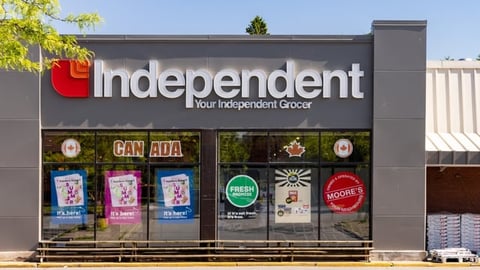To remain competitive, grocers need crosschannel marketing
More and more, customers are moving across channels—in person, online, through social media and apps—to buy what they want, when they want. But, too often, the shopping experience across both digital and physical platforms doesn’t align. This is where a solid omnichannel marketing strategy comes into play. We asked Jason Dubroy, founder of The Commercy, a connected commerce consultancy based in Toronto, for advice on this and more. This interview has been edited for clarity and length.
What challenges do grocers face when implementing an omnichannel strategy?
The first is balancing inventory management and supply chain complexities. Since the pandemic, more people are buying groceries online, but profit lags due to high fulfilment expenses. The second is working with legacy system limitations that can’t sync real-time data across multiple e-commerce engines, mobile apps, in-store and retail media feeds. The final—and potentially the biggest—challenge is the human one: how can you compete against expectations? Shoppers today have been trained to expect free shipping, same-day delivery and real-time stock visibility at store level, which many retailers struggle to get right, even today.
With brick-and-mortar stores still being the primary sales channel, how can grocers keep tech-savvier customers engaged?
The simple insight is tech-savvy shoppers crave digital convenience. Keeping that in mind, there are three areas to focus on. One, making physical stores smarter. We are already seeing some retailers display real-time pricing and recipes—boosting engagement. Two, they’re bridging digital and physical to push aisle-specific deals to customers when they’re near relevant products. Three, the key is to create live experiences, not just transactions. Some host Instagram-worthy cooking demos that can convert to sales, others turn stores into community hubs with free Wi-Fi and charging stations. I think too many grocers still treat online and offline separately. At the end of the day, shoppers don’t want cold automation, they want what they want, but faster and more fun.
How do grocery stores ensure a seamless customer experience across all channels, especially given supply chain challenges?
[Grocery] leaders are making smart moves: some use AI (artificial intelligence) to predict shortages before they happen, some sync inventory across online and [physical] stores so what you see is actually in stock, and some text you when they have to make substitutions with a decent explanation rather than a lame apology. [But], there are still pain points, like getting a valuable digital coupon only to find the item is nowhere in store.
Here’s where I think Canadian grocers can shine: blending tech with a personal touch. Some retailers handwrite substitution notes that make customers smile … it’s not about having the fanciest tech, it’s about using what you’ve got to make shopping feel human again.
READ: The new AI-powered grocery store
How can grocers use cross-channel promotions to boost customer retention?
Canadian grocers need to get surgical with promotions, using data to weave persona lized experiences that feel effortless, whether shopping online, in-app or in-store. Think syncing digital coupons automatically at checkout, or geofenced app alerts nudging you with aisle-specific deals on your usual buys. The winners will layer AI-powered recommendations with phygital gamification. I don’t think it’s just about slashing prices—smart grocers are turning surplus inventory into hyper-local flash sales, letting brands target high-intent shoppers through retail media.
How do you see the role of social commerce (e.g., shopping via social media) evolving in Canada’s grocery industry?
This is the next big thing of next big things. We all know TikTok drives impulse buys from #ViralSnacks to #SupermarketTourism, but only 4% of Canadians currently shop for groceries via socials, far behind the U.S. and even farther behind Asia. High delivery fees are the obvious barrier in this country, but it would be great to see how grocers could leverage TikTok trends like #MealPrepIdeas to drive traffic to in-store “viral item” endcaps, a tactic Whole Foods uses in the U.S.
What are the primary benefits of implementing a retail media network for grocery retailers in Canada, both in terms of revenue and customer engagement?
It’s wild when you realize retail media networks have only been a serious player in Canada for about five or six years and they’re already moving the needle by over a billion dollars annually. That’s real money, and it’s fundamentally reshaping how grocers and brands connect with shoppers, and each other. For suppliers, it’s a game-changer: they’re shifting budgets from spray-and-pray TV ads to performance-driven retail media where every dollar is tied to actual sales. And the real kicker is these platforms aren’t just ad spaces anymore, they’re loyalty engines–using real-time data to tweak promotions on the fly, reward your regular buys and basically make every shopper feel like the store is rolling out the red carpet just for them.
Can you talk about the growing role of personalization in grocery marketing and speak to its importance? What role does AI play in this and what role should it play?
Personalization has moved from nice-to-have to non-negotiable. Shoppers don’t just want stuff, they expect you to know their habits better than they do. This comes from use of first-party data: purchase history, price sensitivity and even dietary quirks, and then using those behavioural breadcrumbs to craft promotions that feel hand-picked. AI isn’t optional here, it’s the engine making this possible and it’s why retailers are deploying AI everywhere from dynamic pricing that adjusts in real time to predictive personalization that serves up your usual grocery item just as you’re running low. While big players like Loblaws and Walmart have dominated with their data firepower, affordable AI tools are finally letting independents play this game, too.
READ: Making personalization profitable
What are the next big opportunities or innovations for grocery retailers in Canada to explore?
The Canadian grocery industry is at a turning point, caught between inflationary pressures, rapid tech adoption and evolving consumer demands. To not just survive, but thrive, I think retailers need to focus on a few key areas. Leveraging AI and machine learning is critical for dynamic pricing, smarter inventory management, and unlocking the full value of first-party data through retail media. Also, sustainability can’t just be a talking point. Cutting food waste with AI-powered markdowns or blockchain-tracked freshness is now a business imperative. Finally, younger shoppers are expecting seamless, interactive experiences, and grocers must experiment with livestream commerce, gamified rewards, and hyper-personalized promotions to stay relevant.
What tech trends should grocers keep an eye on?
There are the obvious ones like integrating AI for both operational and customer-facing gains like predictive replenishment, scaling seamless checkout experiences and adopting sustainable supply chain technologies to align with regulatory and consumer expectations. On the other side are the cultural tech trends, including shopper-generated content like reviews on shelf tags and user submitted recipe videos, blockchain receipts, reusable packaging networks, robotic dark stores and micro-fulfillment hubs for 10-minute deliveries in urban cores, just to name a few.
This article was first published in Canadian Grocer’s May 2025 issue.




